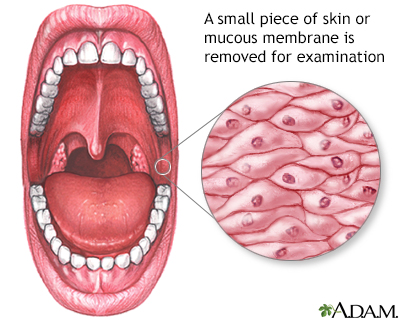Skin or nail culture
Mucosal culture; Culture - skin; Culture - mucosal; Nail culture; Culture - fingernail; Fingernail culture
A skin or nail culture is a laboratory test to look for and identify germs that cause problems with the skin or nails.
It is called a mucosal culture if the sample involves the mucous membranes.
Images


I Would Like to Learn About:
How the Test is Performed
Your health care provider may use a cotton swab or knife blade to collect a sample from an open skin rash or skin sore.
A sample of skin may need to be taken. This is called a skin biopsy. Before the skin sample is removed, you will likely receive a shot (injection) of numbing medicine to prevent pain.
A small sample of a fingernail or toenail may be taken. The sample is sent to a lab. There, it is placed in a special dish (culture). It is then watched to see if bacteria, viruses, or fungi grow. It may take up to 3 weeks to get results of a nail culture. Further tests can be done to identify the specific germ that is causing your problem. This can help your provider determine the best treatment.
How to Prepare for the Test
There is no preparation needed for this test. If a skin or mucosal sample is needed, your provider will tell you how to prepare.
How the Test will Feel
If a skin biopsy is done, you may feel a sting when the shot of numbing medicine is given.
For a nail sample, the provider scrapes the affected area of the nail or clips off a piece of the nail. There is usually no pain.
Why the Test is Performed
This test may be done to diagnose the cause of:
- A bacteria or fungus infection of the skin, finger, or toenail
- A skin rash or sore that appears to be infected
- A skin ulcer that is not healing
Normal Results
A normal result means no disease-causing germs are seen in the culture.
Some germs normally live on the skin. These are not a sign of infection and are considered a normal finding.
Normal value ranges may vary slightly among different laboratories. Some labs use different measurements or test different samples. Talk to your provider about the meaning of your specific test results.
What Abnormal Results Mean
An abnormal result means bacteria, fungus, or virus is present. This may be a sign of infection.
Common skin infections caused by bacteria include:
Common skin infections caused by fungus include:
Risks
Risks include slight bleeding or infection in the area where the skin sample was removed.
References
Dinulos JGH. Dermatologic surgical procedures. In: Dinulos JGH, ed. Habif's Clinical Dermatology: A Color Guide in Diagnosis and Therapy. 7th ed. Philadelphia, PA: Elsevier; 2021:chap 27.
Iwen PC, Thompson GR, Wiederhold NP. Mycotic diseases. In: McPherson RA, Pincus MR, eds. Henry's Clinical Diagnosis and Management by Laboratory Methods. 24th ed. Philadelphia, PA: Elsevier; 2022:chap 60.
Wojewoda CM, Stempak LM. Medical bacteriology. In: McPherson RA, Pincus MR, eds. Henry's Clinical Diagnosis and Management by Laboratory Methods. 24th ed. Philadelphia, PA: Elsevier; 2022:chap 57.
BACK TO TOPReview Date: 7/8/2023
Reviewed By: Linda J. Vorvick, MD, Clinical Professor, Department of Family Medicine, UW Medicine, School of Medicine, University of Washington, Seattle, WA. Also reviewed by David C. Dugdale, MD, Medical Director, Brenda Conaway, Editorial Director, and the A.D.A.M. Editorial team.

Health Content Provider
06/01/2025
|
A.D.A.M., Inc. is accredited by URAC, for Health Content Provider (www.urac.org). URAC's accreditation program is an independent audit to verify that A.D.A.M. follows rigorous standards of quality and accountability. A.D.A.M. is among the first to achieve this important distinction for online health information and services. Learn more about A.D.A.M.'s editorial policy, editorial process and privacy policy. A.D.A.M. is also a founding member of Hi-Ethics. This site complied with the HONcode standard for trustworthy health information from 1995 to 2022, after which HON (Health On the Net, a not-for-profit organization that promoted transparent and reliable health information online) was discontinued. |
The information provided herein should not be used during any medical emergency or for the diagnosis or treatment of any medical condition. A licensed medical professional should be consulted for diagnosis and treatment of any and all medical conditions. Links to other sites are provided for information only -- they do not constitute endorsements of those other sites. © 1997- 2025 A.D.A.M., a business unit of Ebix, Inc. Any duplication or distribution of the information contained herein is strictly prohibited.
